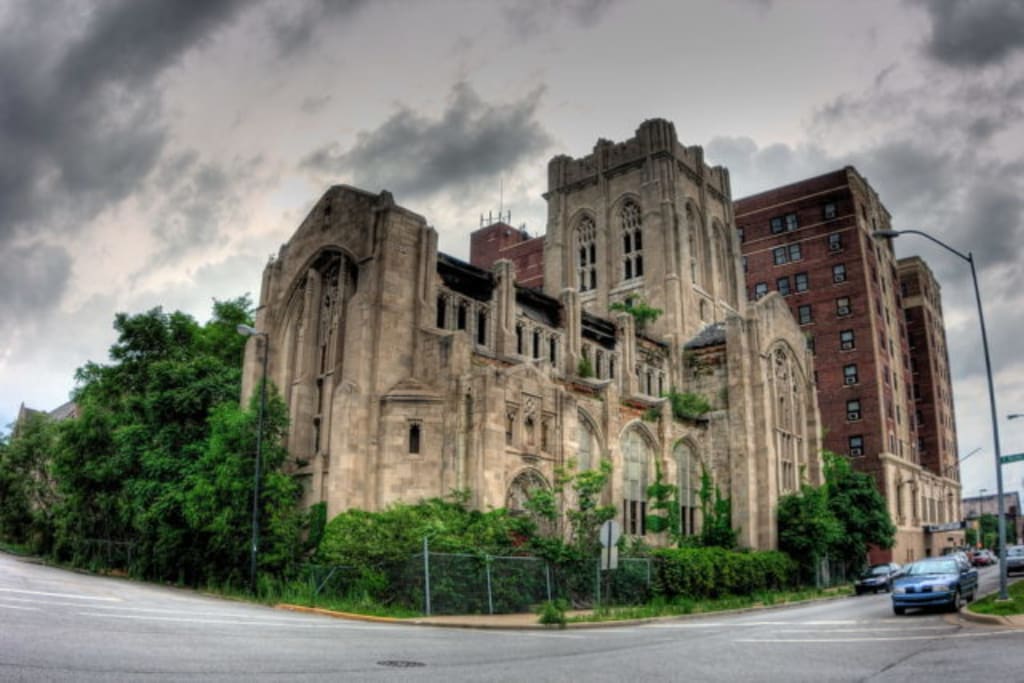Derelict Methodist Church, Gary, Indiana
Abandoned Churches

City Methodist Church of Gary, Indiana is arguably the most beautiful example of urban decay in the Rust Belt. The Gothic Revival structure, which stands in ruins after decades of neglect, arson and vandalism, is stunning to behold. The City Methodist Church, latterly known as City United Methodist Church is a disused church in Gary, Indiana. Once the largest Methodist church in the Midwest, it ceased as a place of worship in 1975 after a relatively brief life of just over 50 years.
The derelict Urban Methodist Church appeared on Washington Street in Gary, Indiana in 1926. Dr. William Grant Seaman, the future pastor of the church, came up with the design for it in 1916. He wanted to build a church big enough to serve the city.
The primary employer in the city at that time was the American Steel Corporation US Steel, and Seaman was able to get support from them for his project.
Construction was only made possible because US Steel provided half the cost of the entire construction. In addition, it also donated the land on which the church was built.
Construction began in 1925, with Lowe and Bollenbacher from Chicago contracted to carry out the work. The church was built in the Gothic style, but the windows were made of plain glass rather than stained glass in an effort to reduce the expense.
Elbert Gary, after whom the city was named, presented the church with an organ as a gift.
After 21 months, everything was ready. The final cost of the church was $800,000, a staggering amount at that time. On October 3, 1926, the first service was held.
The church’s sanctuary was located at the front of the building. Adjoining it was a theater called Seaman Hall which could accommodate 1,000 people.
There was also a complex containing offices, a canteen, a gymnasium, and a Sunday school. A roof garden was also part of the design, but it was never completed.
In 1927, the church employed six people, and 1,700 people would attend the services. In 1929, Pastor William Seaman became less popular among his parishioners due to his interests in cultural diversity. Eventually, he moved to Ohio.
By 1930, Gary was thriving with more than 100,000 people calling it home. The Methodist City Church also remained popular and, in the 1950s, had a membership of over 3,000 people. The church was completed when Gary was at its most populous; by 1930 more than 100,000 people called it home. After World War II, modernization at the steel mill greatly reduced the number of workers on payroll, leaving thousands without work. The layoffs were particularly painful for the African American community, which had fewer options for employment and relocation in a city that was sliding into deep decline. In the 1960s and 1970s, the city itself began to decline and, likewise, the church started to collapse. More affluent residents left the city, and the crime rate began to rise. Furthermore, the maintenance of the church became impossible through a combination of its enormous size and the harsh climate.
In the 1970s, the metallurgical industry in the city collapsed. Companies began to reduce the number of jobs, and consequently, the population declined into the hundreds.
In 1973, the church had only 320 members. In 1975, the decision was made to close the largest Methodist church in the Midwest. It became abandoned due to the recession and changing demographics.
After the church was closed, Indiana University continued to use part of Seaman Hall as it had done before. The University did not make any changes or improvements to the church itself and, by the 1990s, the building began to collapse. A fire in 1997 served to accelerate its decline.
The site is now unstable and parts often collapse. In June 2011, about a quarter of the roof was destroyed. Soft spots and big holes make the area unsafe for visitors.
Despite its ruined appearance, the church is still an attractive place for film crews, photographers, and lovers of abandoned places. By 2010, 24 films had been shot in the city of Gary which included scenes from the church.
This place has even become popular among people who want to hold Gothic weddings and various receptions there. However, since 2016, permission from the Gary Film and Television Office has been required to visit the former church.
In 2014, the city decided to revisit an aborted plan to build a large park in this area. In June 2017, the city won a grant of $163,333 as part of the Knight Cities Challenge competition. This money is earmarked to be spent on stabilizing the structure and turning the site into a ‘ruins garden’ as an attractive venue for weddings.
About the Creator
Tami Osburn
I am just a writer who loves to write. Please enjoy my stories and poems. You can also find me on Amazon.com as an indie writer. Look me up there as well.






Comments
There are no comments for this story
Be the first to respond and start the conversation.